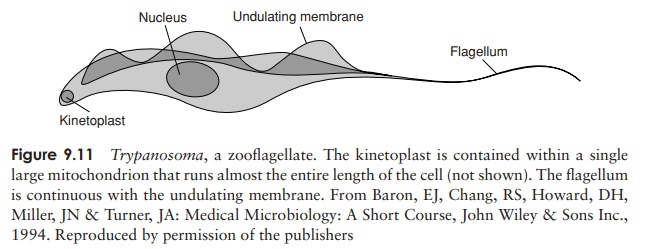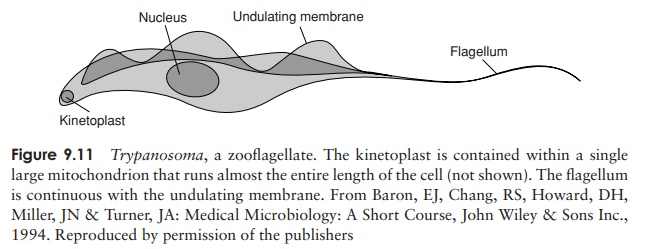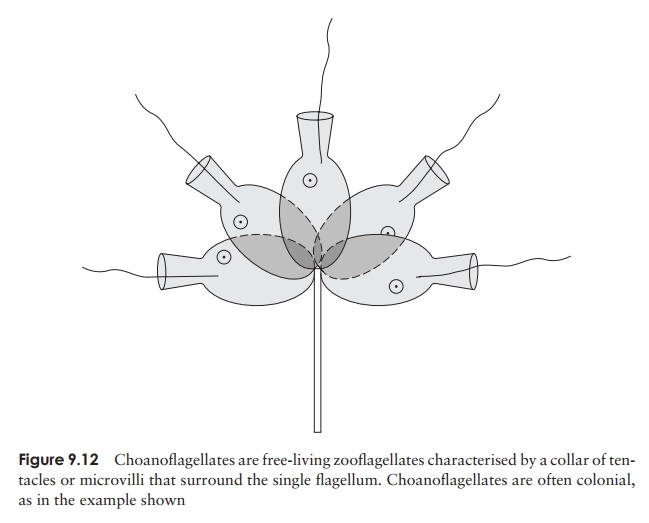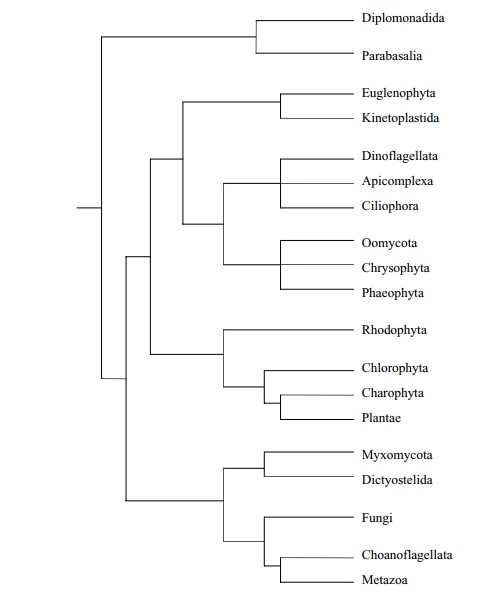Chapter: Essential Microbiology: Protista
Zooflagellates (Mastigophora) - Protozoa

The
zooflagellates (Mastigophora)
Members of this, the biggest and most primitive group
of protozoans, are characterised by the long flagellum (mastigos= ‘a whip’), by which they propel themselves around.
Although typical zooflagellates have a single flagellum, some types possess
several. The prefix ‘zoo-’ distinguishes them from plant-like flagellates such
as Euglena, but as we have already
mentioned, such a distinction is not necessarily warranted on molecular and
structural grounds.

Zooflagellates may be free-living, symbiotic or
para-sitic. An example of the latter is the causative agent of African sleeping
sickness in humans, Trypanosoma bru-cei (Figure
9.11). This belongs to the kinetoplastids, agroup characterised by the
possession of a unique or-ganelle called the kinetoplast, found within the cell’s single, large, tubular
mitochondrion, and containing its own DNA. The flagellum extends back to form
the edgeof a long, undulating membrane
that gives Trypanosoma its
characteristic locomotion. The infectious form of T. brucei develops in the salivary glands of the intermediate host,
the tsetse fly, and is passed to the human host when a bite punctures the skin.
Here, it eventually reaches the central nervous system by way of the blood or
lymphatic systems. Inflammation of the brain and spinal cord results in the characteristic
lethargy,coma and eventual death of the patient.
Reproduction in the zooflagellates is generally by
binary fission. In the case of T.brucei,
this occurs both in the human host and in the gut of the tsetse fly, from which
itmigrates to the salivary glands to complete its life-cycle.

The choanoflagellates (Figure 9.12) are a group of
zooflagellates of particular in-terest, as it is thought that they represent
the closest single-celled relatives of animals. They possess a ‘collar’ of
microvilli that surrounds the base of a single flagellum, an arrangement that
is also seen in the simplest multicellular animals, the sponges. This
connection is made even more apparent in colonial forms of choanoflagellates,
and is supported by molecular evidence. Also, both choanoflagellates and
animals share the flat, lamellar type of cristae in their mitochondria.
A third group of zooflagellates worthy of note are
the diplomonads. These have two nuclei per cell and multiple flagella, but
their most remarkable feature is that they do not apparently possess any
mitochondria. Giardia lamblia, the
causative agent of the intestinal disease giardiasis, is a member of this
group. Unlike Trypanosoma, Giardia does not have a secondary host,
but survives outside the body as a resistant cyst,before it is taken up again
in infected water. The diplomonads occupy a very distant branch of suggested
phylogenetic trees from the kinetoplastids and choanoflagellates (see Figure
9.18). The parabasalians are another group of amitochondriate flagellates,
whose best-known member is Trichomonas
vaginalis, a cause of infections of the female urogenital tract.


Related Topics